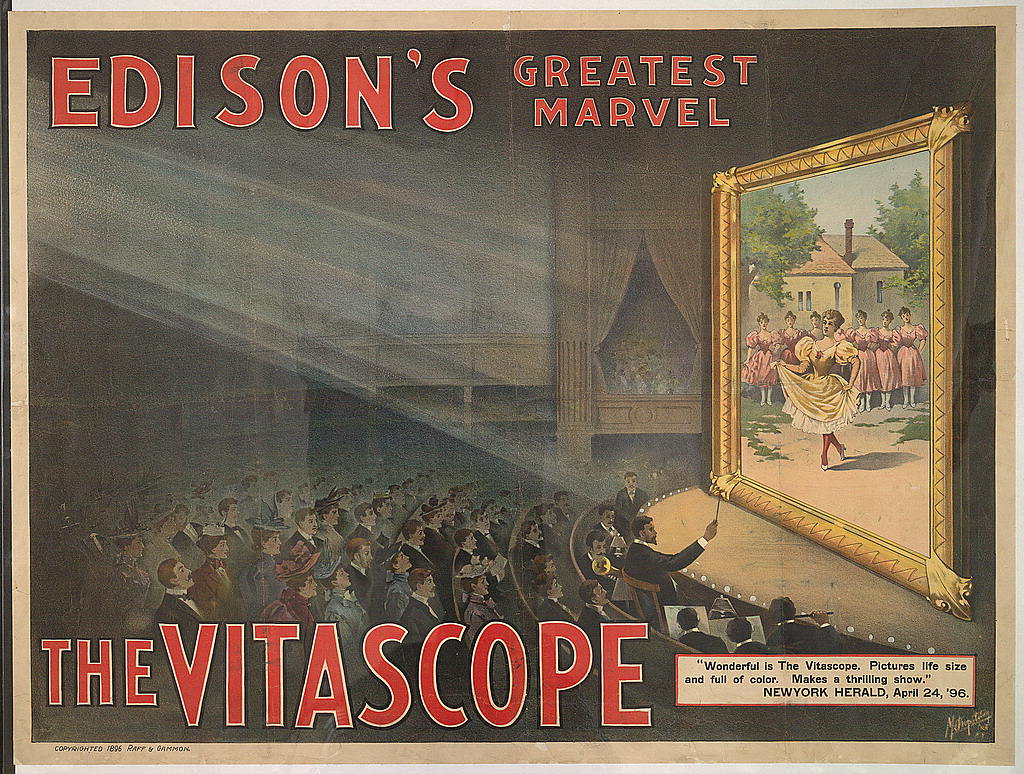
The Vitascope is an early motion-picture projector that was developed from Thomas Jefferson’s Kinetoscope and patented by Thomas Armat in 1895. The creation of this projector caused a revolution around the world. By creating a device that could display images and sound at the same time, the film industry was born. As historian George Lathrop notes, “these ‘living pictures’ in a new sense – these illuminated shadows that have all the naturalness – and a nearly perfect semblance, of reality – could, he said, be used in conjunction with the phonograph and be substituted for real persons and dialogue spoken by them in plays upon the stage.” Prior to the 1890s, the world had never seen an invention like this before, which sparked curiosity from people across the globe. This 1896 advertisement from the New York Metropolitan Print Company was just the start of a new entertainment medium, which has had significant developments since then. Film and cinema historian Robert C. Allen reinforced this when saying “by 1895, the Edison Company had demonstrated the practicability of motion photography, begun regular production of films for use in the Kinetoscope, and established the commercial usefulness of the motion picture as a popular entertainment novelty.” From here, the Edison Company was able to expand upon its current invention and develop it into something even greater. This occurred when two businessmen, Raff and Gammon, heard about Edison’s invention as well as a new type of projector from Thomas Armat. By combining the technicalities of the two projectors, viewing films became easier than before, compared to when a person had to look into the projector and crank the handle to start the projection. Right around when the partners, Raff and Gammon, were trying to sell their flopping businesses and move on, historian Robert C. Allen notes that they learned of the Vitascope in January of 1896. “They concluded negotiations by which Raff and Gammon received the license to market the device on a territorial rights basis. To avoid potential patent litigation and to assure a supply of films, they also contracted for the Edison Company to manufacture the projector and provide films.” If the two groups had not collaborated, the Vitascope and cinema as it is now known might not have been developed. Although the advertisement displays Edison’s name in big, bold lettering, he did not contribute as much to the projector as people may think. “The only thing Edison had contributed to the development of the Vitascope was the imprimatur of his name, yet Raff and Gammon promoted the projector as the latest marvel from the Wizard’s workshop – a ruse which, no doubt, was largely responsible for the generous publicity given the Vitascope.”. By attaching a popular name to the new invention, Raff and Gammon were able to drum up both business and interest in the film industry. The decision to do this stemmed from a lack of confidence in the invention. The two businessmen were wary of its initial release and were unsure how the public would respond to it. After its release, the issue turned from a lack of popularity to a struggle in obtaining and supplying audiences with films. Once the logistics behind providing films was figured out, the theater and cinema industry was able to thrive. It acted as a safe-haven and a distraction from the struggles that the dawn of a new century brought. People were able to be whisked away and not think about the hard-hitting problems of the world, such as poverty, war and hunger. This invention provided both relief and entertainment for a world that desperately needed it and also laid the foundation for the history of cinema.
Works Cited
Allen, Robert C. “Vitascope/Cinématographe: Initial Patterns of American Film Industrial Practice.” Journal of the University Film Association, vol. 31, no. 2, Apr. 1979, pp. 13–18. EBSCOhost, https://search.ebscohost.com/login.aspx?direct=true&AuthType=sso&db=edsjsr&AN=edsjsr.20687471&site=eds-live.
Lathrop, George P. “Stage Scenery and the Vitascope.” The North American Review, vol. 163, no. 3, Sep 01, 1896, pp. 377. ProQuest, https://www.proquest.com/magazines/stage-scenery-vitascope/docview/1296811509/se-2.
Singer, Ben. “Early Home Cinema and the Edison Home Projecting Kinetoscope.” Film History, vol. 2, no. 1, Jan. 1988, pp. 37–69. EBSCOhost, https://search.ebscohost.com/login.aspx?direct=true&AuthType=sso&db=ufh&AN=31286322&site=eds-live.
